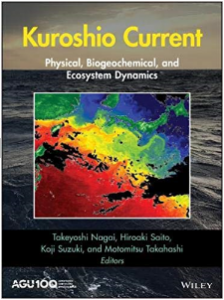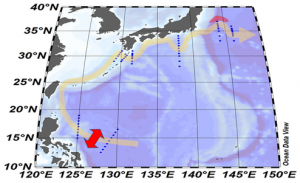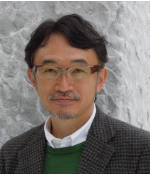Summary of the project
Kuroshio is a warm western boundary current of the North Pacific Ocean flowing along Rhukyu Islands and Japan. In spite of low-nutrient concentration of Kuroshio water, various fish species use the Kuroshio region as spawning and/or nursery grounds, and good fisheries grounds are formed in the region. In order to understand the mechanisms of high fisheries productivity from oligotrophic condition, i.e., Kuroshio Paradox, and to find a way for sustainable use of the ecosystem services, we started an interdisciplinary research project SKED (Study of Kuroshio Ecosystem Dynamics for Sustainable Fisheries) in October 2011, funded by the MEXT (Ministry of Education, Culture, Sports, Science and Technology, Japan. SKED is a 10-years project to 2021.
The themes of this project are:
Theme 1: Physical mechanisms controlling the variability in nutrient supply
Theme 2: Phytoplankton species composition and productivity
Theme 3: Ecosystem structure and biogenic elemental cycling
Theme 4: Fisheries and ecosystem interactions
Theme 5: Mathematical model analyses for understanding the ecosystem dynamics and sustainable use of ecosystem services
To reach the goal of SKED, we use both mathematical modeling and field observation including satellite remote sensing.
Area of study
Kuroshio region (from Chinese Taiwan to Japan), western North Pacific
Time Table for activities
October 2011 – March 2021
Project Updates
Major achievements
- Finding multi-processes of nutrient supply along the Kuroshio, which support new production, and then zooplankton and fish production in oligotrophic Kuroshio region. Multiscale routes to supply nutrients through the Kuroshio nutrient stream, In: Kuroshio Current: Physical, Biogeochemical and Ecosystem Dynamics (T. Nagai, S. Clayton and Y. Uchiyama), AGU-Wiley, accepted. (In Press). Nutrient interleaving below the mixed layer of the Kuroshio Extension Front (Takeyoshi Nagai and Sophie Clayton), In Ocean Dynamics, volume 67, 2017. First Evidence of Coherent Bands of Strong Turbulent Layers Associated with High-Wavenumber Internal-Wave Shear in the Upstream Kuroshio (Nagai et al.), In Scientific Reports, volume 7, 2017.
- Finding “tunicate food chain” supporting higher trophic organisms such as fish based on pico-, and nanophytoplankton dominated Kuroshio ecosystem. Okazaki, Y., Miyaoto, H., Suzuki, K., Saito, H., Hidaka, K., and Ichikawa, T. (in press), Diverse trophic phathways from zooplankton to larval and juvenile fishes in the Kuroshio ecosystm. in Nagai, T., Saito, H., Suzuki, K. (ed). Kuroshio Current: Physical, Biogeochemical, and Ecosystem Dynamics. AGU-Wiley Geophysical Monograph.
- Influence of the Kuroshio on culture and society of Japan. Saito, H. (in press) The Kuroshio: its recognition, scientific activities and emerging issues. in Nagai, T., Saito, H., Suzuki, K. (ed). Kuroshio Current: Physical, Biogeochemical, and Ecosystem Dynamics. AGU-Wiley Geophysical Monograph.
- Recent findings from the SKED as well as some comparative studies of the Kuroshio and Gulf Stream were published in Nagai, T., Saito, H., Suzuki, K. (ed). Kuroshio Current: Physical, Biogeochemical, and Ecosystem Dynamics. https://www.amazon.co.jp/Kuroshio-Current-Biogeochemical-Ecosystem-Geophysical/dp/1119428343

- Some results were presented at the 8th IMBeR CJK symposium, Shanghai, Sep. 2018.
- In PICES (North Pacific Marine Science Organization) Annual Meeting in Yokohama, Oct. 2018, SKED scientists convened a topic session “Fish production through food web dynamics in the boundary current systems”. https://meetings.pices.int/meetings/annual/2018/PICES/Program
Upcoming activities
- Hakuho-Maru cruise (34 scientists on board). Tokyo-Naha(Okinawa)-Manila. June 29-Aug.2, 2020.

